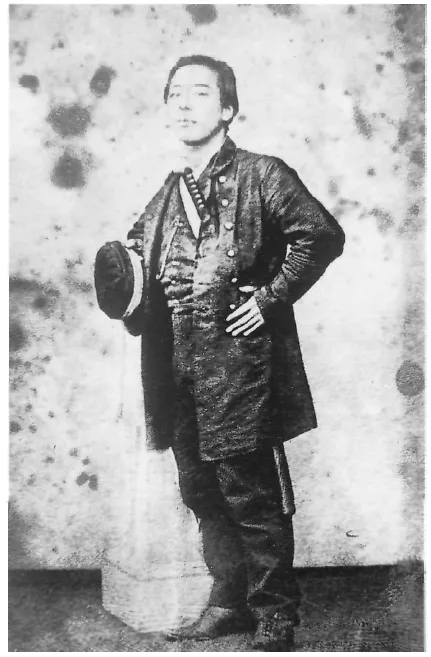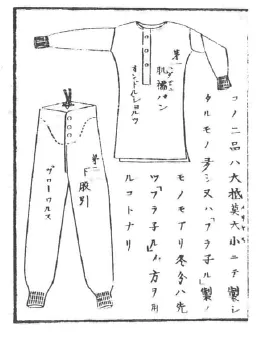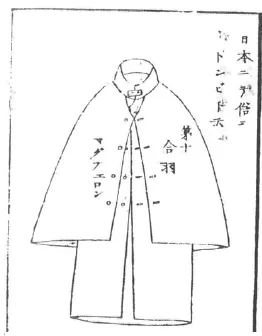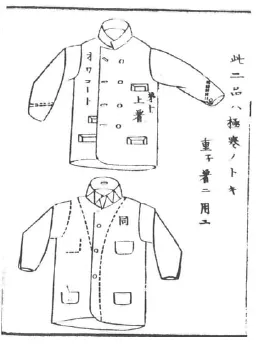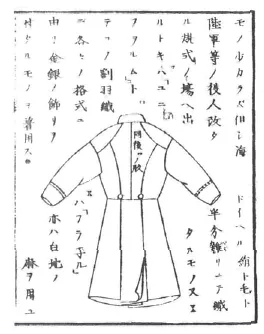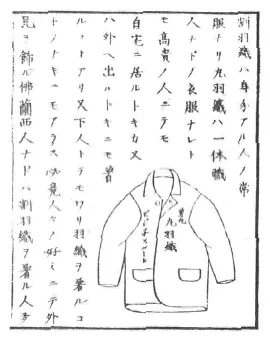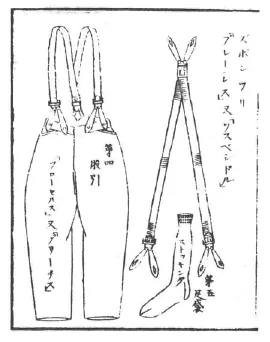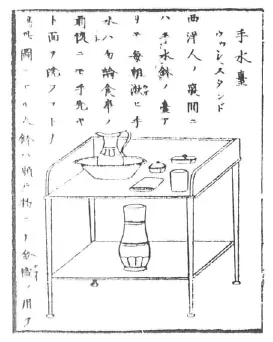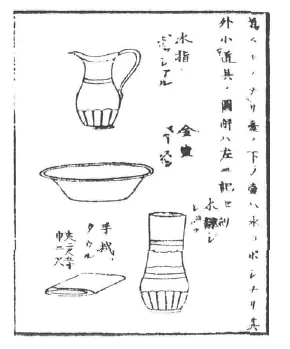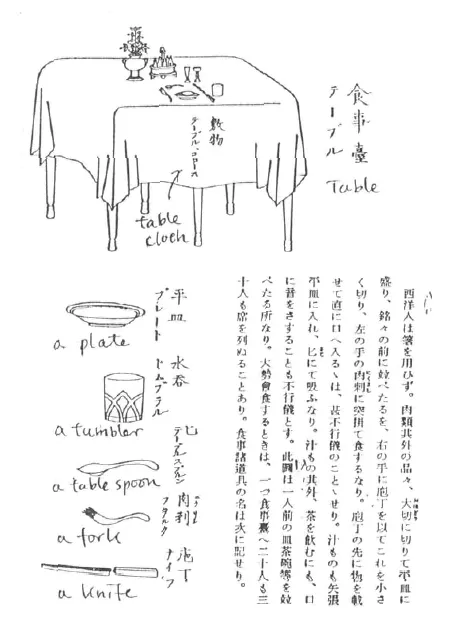Figure 1.1 Samurai, clumsily dressed in Western clothes with Samurai sword
1 Shirts, studs and wash hand basins
Japanese gentlemanship
For over 200 years the Japanese had been denied contact with people other than their compatriots. Only when, after 1859, delegations of Japanese left the country to explore the West did their ignorance of the outside world become apparent.
Fukuzawa Yukichi, who alone amongst the Japanese made three journeys to the West before the Meiji Restoration of 1868, was sensitive to his fellow countrymen’s embarrassment. He himself had been mortified by Japanese abroad, as he wrote:
Before our departure, the organisers of the embassy had decided that we should carry all the necessary food, because agreeable food would not be available in foreign lands. So hundreds of cases of polished rice were put in our baggage. Likewise … they had provided dozens of very large lamps (a frame-work, two feet square, for an oil-burning wick with paper sides and wire coverings). Then they ordered smaller lamps, portable lanterns, candles – all the necessities of travel customary in our native country.1
This was awkward, as wherever the Japanese were lodged, European governments housed them in grand hotels, gas lit and warm. They were offered ‘such a spread of food, delicacies “both of the woods and of the seas” ’ that they were spoiled for choice. Everywhere they travelled in Europe they were treated as honoured guests.
The early delegations of Japanese to Britain appeared resplendent, if outlandish, in their traditional dress. What on earth were they wearing? The British public were excited but puzzled. Pictures of these exotic figures appeared in the newspapers to the delight and astonishment of the British public. If Japan was to become part of the modern world then something had to be done to create a Japanese gentleman who was appropriately dressed.
It was Fukuzawa Yukichi (1835–1901) who tackled this cultural difficulty. As he noted, when the Japanese arrived in Europe in 1862, ‘We all wore our Japanese dress with a pair of swords in our girdles, and appeared on the streets of London in such attire. A sight indeed it must have been.’2
Under the guidance of Fukuzawa, Katayama Junnosuke wrote the preface to, and prepared, Seiyoishokuju [Guide Book to Everyday Clothes and so on in European Style], which appeared in November 1867, that is, on the eve of the Meiji Restoration. The book was republished in 1994 by the Fukuzawa Memorial Centre at Keio University.3 Seiyoishokuju was very useful for those planning to travel abroad.
The young Japanese also needed a tailor. It would appear that Keio College did initially provide a tailoring service. But, in 1873, this was transferred to Maruzan in Yokohama. To move the tailoring service to Yokohama was a sensible and logical step given the availability of foreigners, and foreign tailors, in the treaty port.
For the purpose of this study a few pages of Seiyoishokuju have been reproduced. These show drawings of Western clothes, washing facilities and basic furniture, together with a translation into English of the Japanese text that accompanied the pictures.
Food, clothing and shelter in the West
There are many people who wear Western style clothes recently. It is needless to say that Western clothes are very convenient not only for soldiers but also for people who work outside. Many Japanese, however, do not quite understand how to wear them and make mistakes such as putting on a warm jacket in the summer or wearing it as underwear. This book is written to give a general knowledge of the Western way of living for Japanese who do not know much about it.
Clothing
These two (undershirt and drawers) (see figs 1.2 and 1.3) are made mostly from knit cotton or some from flannel. People usually use the ones made from flannel in winter. Shirts, made from calico or hemp, are for general use. Flannel shirts are used during trips. Because they are woollen they do not get dirty easily.
The collar (fig 1.4) is made of hemp, some paper-made. The latter ones are inexpensive, but you have to throw them away after using them for only one day. Do not forget to put this collar on. Otherwise, it is as if you wore underwear (worn with a kimono) with han-eri (a collar for kimonos). It is very inexcusable.
Ordinary shoes (see fig 1.5) are substitutes for geta. Boots are used in rainy weather or on horseback. Slippers are substitutes for uwa zori, used inside. A shoehorn is used, putting it between your heels and shoes and slide it to make it easy to put on the shoes.
A gentleman’s coat (see figs 1.6 – 1.9) is everyday clothing for people of the upper classes. A business coat is for ordinary people; upper-class people, however, wear it when they are both in and out. Even servants sometimes wear it. It depends on each person’s taste. The French, who like dressing up, usually put on a gentleman’s coat. The Americans and the British, on the other hand, do not care how they look, like a Tokyoite. They do not care as long as their underwear is clean, and are unconcerned about their outerwear. Many of the upper classes wear business jackets. Only soldiers and sailors of high rank wear ‘uniform’ with badges made of gold or silver according to their class on formal occasions. There are many kinds of uniform, but it is difficult to show all of them here. These kinds of coat are made of cashmere, that is fine wool woven with silk and wool, half each, or flannel, or white hemp.
Figure 1.2 Undershirt and drawers
Figure 1.5 Shoes and shoehorn
A hat (see fig 1.10) is for upper class and a cap for middle and lower classes. Although the cap is for lower-class people, upper-class people also wear it. It is the same as in the case of business jackets. In general, you should remember that you put on a hat when your wear a gentleman’s coat, and a cap when wearing a business jacket. Ordinary people sometimes wear caps, but mostly they are for army and naval officers. In front of a cap, each of them put badges made of gold or silver, or ribbons according to their classes. Therefore, when you see the person wearing the cap with gold and silver coloured ribbons, you should take him as an officer in his country.
This is a brief sketch (see figs 1.11 and 1.12) of the clothing in the West. You wear them in order of the number on the figure. First, wear undershirt, second, drawers, third, shirt, and so forth. The last is putting on the jacket. Their clothes usually have pockets everywhere in which to put your belongings. For example, you can put your handkerchief in your jacket pocket, your purse in your trouser pocket, and place your watch in your waistcoat pocket and hook the chain at one of the buttonholes and so on. When you go to the toilet, you can just relieve yourself by unbuttoning your trousers and jacket. In the case of defecation, you have to unbutton the same parts, both front and back of braces. When you are finished, you button them again. Since you cannot see the back button, it is very inconvenient until you get used to it.
Figure 1.12 Trousers and braces
Figure 1.14 Basin, jug, etc.
There is a wash stand (fig 1.13) in the Western-style bedroom. They wash their face, hands and teeth every morning and after a meal. On the wash stand is a basin made of porcelain that is a substitute of the metal basin we use. Under the washstand is a jug. Figures of the other appliances are as follows.
This figure (fig 1.15) shows drawers with a mirror on it. It is too difficult to wear Western clothes without looking into a mirror such as reaching for buttons. Because they brush their hair every morning and evening every room has a mirror inside. After putting on the clothes, they wear perfume to keep it clean. At the left side of the mirror on the drawer is a smelling bottle. In front of the mirror is a brush, which is used for dusting clothes. All in all, the Western person likes to be clean more than Japanese do.
Figure 1.15 Chest of drawers
The Figure on this page show a table setting for one person, and other tableware. When you dine with many guests, there can be twenty or thirty people sitting around a dining table all together. In usual meals, they drink red wine, sherry wine, port wine, etc. When they have guests or ceremony they drink champagne and other tasty wines. Liqueur and brandy are served in small glasses after a meal. Beer is malt liquor and has a bitter taste. It is good to have a heart-to-heart talk over a glass of beer. Some people appreciate its bitterness. Whisky and brandy are too strong to drink during the meal. They are usually for servants.
Figure 1.16 Table setting
The watch is quite different from the topic we are talking about now. It is, however, their custom that we should be informed of. In the West, they know the time not by the boom of a temple bell but by a watch they always bring with them. Recently, it is getting popular that people here wear the foreign-made watch. Sometimes they do not know how to read it.
Since they divide one day into twenty-four hours, an hour for them is...

